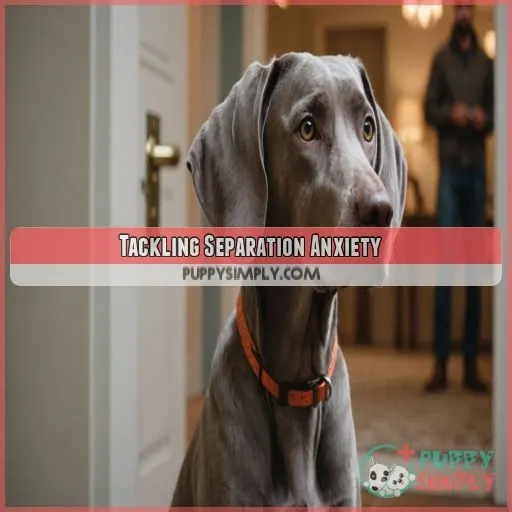This site is supported by our readers. We may earn a commission, at no cost to you, if you purchase through links.

This approach tackles multiple skills at once, boosting obedience, socialization, and mental stimulation.
By combining positive reinforcement techniques, like clicker training, with high-energy exercise needs and socialization skills, you’ll be well on your way to a more confident, calm Weimaraner.
And the best part? Cluster training is suited to adult dogs, so you can skip the puppy training woes and jump straight into creating a stronger bond with your furry friend.
What’s next?
Table Of Contents
- Key Takeaways
- Weimaraner Training Basics
- Tackling Separation Anxiety
- Effective Training Methods
- Managing Weimaraner Energy Levels
- Addressing Common Behavioral Issues
- Building a Strong Owner-Weimaraner Bond
- Advanced Training for Weimaraners
- Frequently Asked Questions (FAQs)
- What is the best training for Weimaraners?
- Are Weimaraner dogs hard to train?
- How to tire out a Weimaraner?
- How do you treat separation anxiety in Weimaraners?
- How does Weimaraner cluster training impact socialization skills?
- Can adult Weimaraners learn to walk on a loose leash?
- What role does positive reinforcement play in cluster training?
- How does cluster training address Weimaraner prey drive instincts?
- Can cluster training help Weimaraners adapt to new environments?
- Conclusion
Key Takeaways
- You’re not too late to the party! Cluster training is specifically designed for adult dogs, so you can skip the puppy training woes and jump straight into creating a stronger bond with your furry friend. With this approach, you’ll tackle multiple skills at once, boosting obedience, socialization, and mental stimulation.
- Get ready to sweat! As a Weimaraner owner, you know your furry friend needs regular exercise to stay happy and healthy. From running exercises to hiking adventures, find activities that you both love and make them a regular part of your routine. This will help burn off excess energy and prevent destructive behavior.
- It’s time to get social! Cluster training places a strong emphasis on socialization skills, which are crucial for adult dogs. Start with short, controlled interactions at the dog park, and gradually increase exposure to new people and environments. With patience and consistency, you’ll help your Weimaraner become a confident, calm companion in no time.
- You’ve got this! With cluster training, you’ll learn how to redirect unwanted behaviors, such as Separation Anxiety and destructive chewing, and replace them with positive habits. By combining positive reinforcement techniques, like clicker training, with high-energy exercise needs and socialization skills, you’ll be well on your way to raising a well-behaved, loving companion.
Weimaraner Training Basics
You’re about to begin a training adventure with your Weimaraner, and with the right approach, you’ll be well on your way to raising a well-behaved and loving companion. To get started, let’s explore the essentials of Weimaraner training basics, including high-energy exercise needs, positive reinforcement techniques, and socialization skills specifically suited for adult dogs.
High-Energy Exercise Needs
You’re the proud owner of a Weimaraner, a high-energy breed that needs regular exercise to stay happy and healthy. Here are three ways to get your Weimaraner moving:
- Running Exercises: Take your Weimaraner on a 30-minute run around the block or a nearby trail.
- Biking Companions: Attach a dog trailer to your bike and enjoy a leisurely ride together.
- Hiking Adventures: Explore nearby hiking trails and enjoy the great outdoors with your Weimaraner by your side.
Positive Reinforcement Techniques
Now that you know your Weimaraner needs high-energy exercise, let’s talk positive reinforcement techniques.
Clicker training is a game-changer. It uses tasty treats and precise timing to shape desired behaviors.
Create a reward schedule to keep things exciting. This will help maintain your dog’s interest and motivation.
Verbal cues like "sit" and "stay" will become second nature with practice.
With patience and consistency, you’ll be amazed at how quickly your adult dog learns.
Socialization Skills for Adult Dogs
You’re working on socialization skills with your adult Weimaraner – great job! Start with short, controlled interactions at the dog park, and gradually increase exposure to new people and environments. Practice calming public spaces and stranger danger training. Pay attention to canine body language and reward good manners. Consistency is key to helping your Weimaraner become a confident, well-behaved companion.
Tackling Separation Anxiety
As a Weimaraner owner, you’re probably no stranger to the dreaded separation anxiety that can leave your furry friend frantic when you leave the house. Don’t worry, with some patience, consistency, and positive reinforcement, you can help your adult Weimaraner learn to calm down and relax when you’re away.
Identifying Signs of Separation Anxiety
As a Weimaraner owner, you know your furry friend loves attention. But when you leave the house, does your dog go into panic mode? Watch for anxiety indicators like pacing, panting, or destructive chewing. Identify your dog’s unique anxiety triggers and separation behaviors, and get ready to learn calming techniques to ease their stress – and yours!
Gradual Separation Techniques
You’re aware of the signs, now it’s time to tackle separation anxiety. Start with gradual separation techniques. Begin by leaving your Weimaraner alone for short periods, like 5-10 minutes, and gradually increase the duration. Here are some tips to help you:
- Leave a treat-filled toy to keep them occupied
- Create a calming atmosphere with soothing music
- Desensitize your departure cues, like putting on your coat
- Practice "alone time" regularly to make it a normal part of their routine
- Reward calm behavior when you return home
Crate Training for Anxiety Relief
Now that you’ve started gradual separation techniques, it’s time to bring in the big guns: crate training for anxiety relief! By crating your adult Weimaraner, you’re providing a safe space that reduces stress and prevents destructive behavior. Introduce the crate gradually, starting with short periods, and reward calm behavior. This will be a game-changer for separation anxiety prevention.
Effective Training Methods
You’re ready to tap into your Weimaraner’s full potential with effective training methods that will make them a joy to be around. In this section, we’ll explore three powerful training approaches – the Canine Good Citizen (CGC) Program, Clicker Training, and Reward-Based Training Strategies – that will help you raise a well-behaved and loving companion.
Canine Good Citizen (CGC) Program
Now that you’ve tackled separation anxiety, let’s focus on the Canine Good Citizen (CGC) Program. This 10-skill test is perfect for teaching your Weimaraner good manners and reinforcing responsible ownership. CGC training benefits all ages, from puppy socialization to senior dogs, and covers basic obedience commands. Pass the test and earn a certificate, proving your Weimaraner is a well-behaved pet!
Clicker Training for Weimaraners
Now that you’ve got a handle on the Canine Good Citizen program, let’s click into high gear with Clicker Training for your Weimaraner! This technique is a game-changer for behavior modification. Here are three tips to get you started:
- Start with short sessions: 5-10 minutes, max. Weimaraners have short attention spans, so keep it snappy!
- Use positive reinforcement: Reward good behavior with treats, praise, and affection.
- Click at the right moment: Timing is everything in clicker training. Practice your timing to get the best results.
Reward-Based Training Strategies
You’re on a roll with clicker training – now it’s time to boost your Weimaraner’s motivation with reward-based strategies! Choose treats that spark joy, and time them perfectly to reinforce good behavior. Consistency is key, so stick to your routine. Mix it up with praise, playtime, and affection to keep your Weimaraner engaged and motivated.
Managing Weimaraner Energy Levels
You’re probably no stranger to the boundless energy of your Weimaraner, and managing it’s really important to prevent destructive behavior and keep them happy and healthy. By incorporating tire-out activities, mental stimulation techniques, and a specific exercise routine into your daily schedule, you can channel your Weimaraner’s energy into positive outlets and strengthen your bond with them.
Tire-Out Activities for Adult Dogs
You’ve got a high-energy Weimaraner on your hands! Tire them out with activities that are as fun for you as they’re for your furry friend. Try these:
- Visiting the dog park for a game of chase
- Playing fetch games in the backyard
- Exploring new hiking trails
- Splashing around in swimming pools
- Running through agility courses
Mental Stimulation Techniques
Now that you’ve tired out your Weimaraner’s body, it’s time to challenge their mind! Engage their problem-solving skills with puzzle toys, enrichment games, and scent work. Hide treats or kibble around the house or yard, encouraging them to sniff out the goodies. Mental exercises like nose games will keep them stimulated and satisfied, reducing destructive behaviors.
Exercise Routine for Weimaraners
Let’s get your Weimaraner moving! Establishing a regular exercise routine is really important for managing their energy levels. Aim for daily walks, playtime, and mentally stimulating activities. Mix it up with agility training, fetch games, and scent work. This will keep your Weimaraner happy, healthy, and exhausted (in a good way!).
- Run with your Weimaraner through a park or trail
- Set up an obstacle course in your backyard
- Play hide-and-seek or scent games indoors
- Engage in a game of fetch or frisbee
- Incorporate mental stimulation exercises, like puzzle toys or problem-solving games
Addressing Common Behavioral Issues
You’re not alone if your Weimaraner has developed some not-so-charming habits, like chewing on your favorite shoes or counter-surfing for snacks. With patience, consistency, and the right training strategies, you can redirect these behaviors and help your adult Weimaraner become a well-mannered companion.
Redirecting Destructive Chewing Habits
Now that you’ve managed your Weimaraner’s energy levels, let’s tackle those destructive chewing habits. Remember, it’s not about being a "bad dog," but about redirecting their natural behavior. Here’s a helpful table to get you started:
| Chew Toy Selection | Tips for Success |
|---|---|
| Choose durable toys | Supervise playtime to avoid choking hazards |
| Rotate toys regularly | Keep things fresh and exciting |
| Avoid small parts | Opt for sturdy, one-piece toys |
| Offer interactive toys | Challenge your Weimaraner’s problem-solving skills |
| Make it a game | Hide toys around the house for a fun scavenger hunt |
Training for Good Manners
Now that you’ve tackled those pesky chewing habits, it’s time to focus on training for good manners. Think of it as teaching your Weimaraner the art of being a considerate roommate. Here are some essentials to get you started:
- Master housebreaking techniques to avoid accidents
- Teach basic commands like "sit" and "stay" for a more harmonious home life
- Practice leash etiquette to make walks a breeze
Building a Strong Owner-Weimaraner Bond
Spending quality time together is key to building a strong bond with your Weimaraner.
Whether that’s going for a run, playing fetch, or just cuddling on the couch, the time you invest will pay off.
Spending Quality Time With Your Weimaraner
Spending quality time with your Weimaraner is essential for building a strong bond. Engage in playtime activities like fetch, agility training, or scent games that challenge their minds and bodies. Weimaraner playtime ideas like hide-and-seek or obedience training also foster mental stimulation and socialization. Make the most of your time together and watch your relationship flourish!
Trust-Building Exercises
Building trust with your Weimaraner is a two-way street! Engage in trust games like "find the treat" or "hide-and-seek" to strengthen your bond. Reward their loyalty with praise, treats, and affection. As you build this canine connection, you’ll notice a deeper relationship blossoming. Loyalty training is key to a lifelong friendship with your Weimaraner.
Communication Techniques for Weimaraners
Communicating with your Weimaraner is key to a strong bond. Use verbal cues like "sit" and "stay" consistently, and incorporate body language like hand signals. Whistle training can also be effective. Add touch commands like a gentle tug on the leash, and maintain eye contact to keep your Weimaraner engaged. Be patient, and remember, practice makes perfect!
Advanced Training for Weimaraners
As you take your Weimaraner’s training to the next level, you’ll discover new ways to challenge and engage them. With advanced training techniques like agility training, scent work, and refined obedience commands, you’ll be amazed at how your high-energy companion transforms into a well-behaved and loyal friend.
Agility Training for Adult Dogs
Now that you’ve built a strong bond with your Weimaraner, it’s time to challenge them physically and mentally with agility training! Introduce equipment like tunnels, jumps, and weave poles, and watch your adult dog’s confidence soar. Focus on obstacle navigation, conditioning, and flexibility training to help them master jumping techniques and become a pro in no time.
Scent Work and Nose Games
Get ready to tap into your Weimaraner’s superpower – their incredible scent ability!
Scent work and nose games are perfect for mentally stimulating your adult dog. They provide a fun and engaging way to challenge your dog’s mind.
Start with indoor scent games, hiding treats or toys with a strong scent. This allows your dog to develop their skills in a controlled environment.
As they become pros, move on to outdoor games. This will help to further challenge and stimulate your dog.
Remember to reward their efforts and have fun – it’s a game-changer for bonding and exercise!
Refining Basic Obedience Commands
Now that you’ve mastered scent work and nose games, it’s time to refine those basic obedience commands. Think of it as fine-tuning a sports car – you want to make sure everything is running smoothly. Here are 4 areas to focus on:
- Reinforcing Sit Stays: Practice in distracting environments to help your Weimaraner stay focused.
- Mastering Walking Heel: Use verbal cues and rewards to keep them by your side.
- Perfecting Recall Commands: Make recall a game so they’ll come running when called without fail.
- Improving Leash Manners: Teach loose-leash walking to prevent pulling and tugging.
Frequently Asked Questions (FAQs)
What is the best training for Weimaraners?
Ah, old sport, training a Weimaraner is a wild ride! You’ll want to focus on high-energy exercises with your BFF (that’s your Weimaraner, of course!) and consider CGC training for good manners and socialization skills.
Are Weimaraner dogs hard to train?
Don’t worry, you’re not alone! Weimaraners can be a handful, but with positive reinforcement training, consistency, and patience, you can master their energetic and curious nature, turning them into a well-behaved companion.
How to tire out a Weimaraner?
Don’t worry, tiring out a Weimaraner isn’t as exhausting as it sounds! You can wear them out with a mix of physical and mental activities, like agility training, obedience exercises, and even scent games – get creative and have fun!
How do you treat separation anxiety in Weimaraners?
You can help your Weimaraner overcome separation anxiety by starting with short periods of alone time, crate training, and positive reinforcement . Desensitize your departure cues, like putting on your shoes, to reduce stress .
How does Weimaraner cluster training impact socialization skills?
If you’re looking for a way to help your adult dog become more social, Weimaraner cluster training is a great option! This training helps your dog become a confident, calm companion in new situations, making everyday interactions a walk in the park.
Can adult Weimaraners learn to walk on a loose leash?
You can teach your adult Weimaraner to walk on a loose leash with patience, consistency, and positive reinforcement . Start by introducing a no-pull harness and rewarding good behavior, then gradually increase distractions and distance .
What role does positive reinforcement play in cluster training?
You’re the maestro of your dog’s learning journey! Positive reinforcement plays a starring role in cluster training, as it encourages desired behaviors, boosts confidence, and strengthens your bond with your furry friend.
How does cluster training address Weimaraner prey drive instincts?
Did you know 62% of Weimaraners exhibit strong prey drive? You’ll need to channel that energy in cluster training! By focusing on reward-based exercises, you can redirect their instincts and strengthen your bond, making training a breeze.
Can cluster training help Weimaraners adapt to new environments?
You can help your Weimaraner adapt to new environments with cluster training by gradually introducing them to various situations and positive reinforcement techniques (Source). This approach helps build their confidence and calmness in new settings.
Conclusion
You’ve mastered the essentials of Weimaraner cluster training for adult dogs.
You’ve tackled high-energy exercise needs, socialization, and mental stimulation.
You’ve helped your dog become more confident and calm with positive reinforcement and clicker training.
By embracing this holistic approach, you’ve set the stage for a lifelong bond with your Weimaraner.
Continue to nurture this connection through cluster training, and get ready to enjoy the rewards of a well-behaved, loyal friend.













